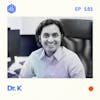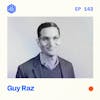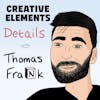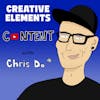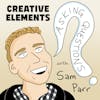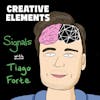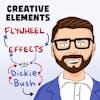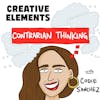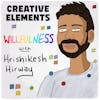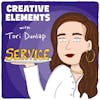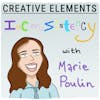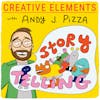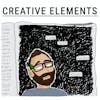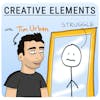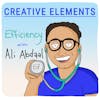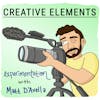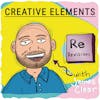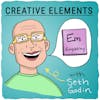
#188: Richard van der Blom – How the man behind the LinkedIn Algorithm Report uses LinkedIn.
Play EpisodeRichard van der Blom creates the celebrated LinkedIn Algorithm Insights report.
Richard van der Blom is the founder of Just Connecting, a social selling and LinkedIn training consultancy based in the Netherlands. And with nearly 200,000 followers on LinkedIn, he's one of the most respected voices on the platform.
Richard was really early to LinkedIn. And as his own reach grew, he started getting a lot of questions about how to best use the platform.
5 years ago, Richard started creating an annual LinkedIn algorithm insights research report. This thing is a gold mine of data driven observations about how different aspects of LinkedIn are working and even how they are trending compared to the year before.
In this episode you'll learn
- Why LinkedIn reach may be down
- What formats are most effective right now
- How to use LinkedIn as a lead generation
- And you'll get a feature by feature breakdown of how Richard himself uses LinkedIn
Full transcript and show notes
Read the 2024 LinkedIn Algorithm Report
Listen to episode #127 with Daniel Murray
***
CONNECT
📫 Get my Professional Creator Crash Course (free)
🧰 Get my full gear list (free)
🙏 Make a guest or mailbag request
📝 Check out our curated Playlists
***
SPONSORS
💼 View all sponsors and offers
***
SAY THANKS
💜 Leave a review on Apple Podcasts
Learn more about your ad choices. Visit megaphone.fm/adchoices
Richard van der Blom [00:00:00]:
So LinkedIn now has a process where they steer the more knowledge based content primarily to your followers. And as soon as you add a selfie, it goes more to your connection. So that's something that you really need to consider.
Jay Clouse [00:00:28]:
Hello, my friend. Welcome back to another episode of Creator Science. Over the last few years, I've been putting a lot of time and effort into publishing on LinkedIn. I consider myself more of a writer than anything else, and LinkedIn felt like a natural extension of the work I was doing on Twitter. Now during that time, LinkedIn has grown a lot as a platform for creators. If you remember my conversation on episode number 127 with Daniel Murray, he called LinkedIn the best platform for underpriced attention, meaning it was easier to get more attention on LinkedIn for the same amount of work on other platforms. But LinkedIn changes and evolves like every other platform. And one of the ways that I stay on top of those changes is by following today's guest, Richard Vanderblom.
Jay Clouse [00:01:14]:
Richard is the founder of Just Connecting, a social selling and LinkedIn training consultancy based in the Netherlands. And with nearly 200,000 followers on LinkedIn, he's one of the most respected voices on the platform.
Richard van der Blom [00:01:26]:
Starting in 2010 with providing very easy training to people. And the more people you welcome in your sessions, the more questions you'll get. And one of the main struggles for a lot of people on LinkedIn is still how to create content that eventually converts into business opportunities.
Jay Clouse [00:01:47]:
Richard was really early to LinkedIn. And as his own reach grew, he started getting a lot of questions about how to best use the platform.
Richard van der Blom [00:01:55]:
And, you know, I can tell a lot of people how I do it. But then a lot of them are going to say, Yes, Richard. But you're a LinkedIn expert on LinkedIn, selling LinkedIn stuff. And I'm a web designer not selling LinkedIn stuff. So for me, it's difficult. So that's why we started to do some more like neutral research, objective research, like, where we could see, like, how do you get more reach? How can you get more traction? What are the do's and don'ts? And that started, like, 5 years ago where we did the research.
Jay Clouse [00:02:24]:
And that brings us to this episode because as you know, I love data. I am a sucker for research. And 5 years ago, Richard started creating an annual LinkedIn algorithm insights research report. This thing is a gold mine of data driven observations about how different aspects of LinkedIn are working and even how they are trending compared to the year before.
Richard van der Blom [00:02:44]:
We did it the first time in 2,000 18. It was a 9 page report. And, actually, when we launched it on LinkedIn, I published it. I mean, it was like a trial. There was no plan behind it. We were really stunned by the massive exposure it got already 5 years ago, like 400,000 views, something like that. And then my network actually started to ask the year after, after 7, 8 months, like, Richard, are you going to do a new research again? Because we've seen some changes. And that was the first time that I realized, hey, maybe this is something that we should do every year.
Jay Clouse [00:03:14]:
So Richard's team kept doing the research report. It was an expensive process. He actually shares the cost of doing the report later in this conversation. But it wasn't easy to get this data.
Richard van der Blom [00:03:25]:
Until last year, the 4th edition, all the research was done by ourselves or by people that we would hire. And then most of it was done manually. So we had, obviously, we have some research tools, but people were actually, like, diving in every 15 minutes into posting what happens. And we started with, I think it was something like 1200 posts in 2018. And last year, we had 9,000 posts manually. And, I mean, it's not just looking at a post manually. It's making print screens every 15 minutes for the first 24 hours. So that was huge.
Richard van der Blom [00:04:01]:
Okay? It was not the most efficient way, but we didn't had data.
Jay Clouse [00:04:05]:
But Richard would soon get more data. Now in year 5, things have gotten even more in-depth. This year's report was the longest ever clocking in at a 123 pages, and it came from the help of a partner who could bring a lot more data to the table.
Richard van der Blom [00:04:20]:
This year, we partnered for the first time with Auto. App. They have 10,000 of people using their tool, which means that they can, like, examine all the things that they are publishing. Like, how many hashtags? How many tags? What type of formats? Are they using external links? So this year, we have done 20,000 posts in our way, which is still the double of last year. And we have done this throughout the whole year. So normally we would do only like 3 months research and then we would write a report. But now we have seen so many things that we decided, let's make it actually like an ongoing research. But then we got 1,500,000 posts data from 1,500,000 posts from Autolop.
Richard van der Blom [00:05:02]:
And funny enough, 80% of the conclusions were aligned. We
Jay Clouse [00:05:06]:
begin this conversation by talking about the 20% of conclusions that were different. But I have a link to the full report as well as Richard's LinkedIn profile in the show notes. I recommend reading the report and following Richard after you listen to this conversation, of course. In this episode, you'll learn why LinkedIn reach may be down, what formats are most effective right now, how to use LinkedIn as a lead generation, and you'll get a feature by feature breakdown of how Richard himself uses LinkedIn. I'd love to hear what you think about this episode. You can send me a message on Twitter or Instagram at jklaus. Tag me. Let me know what you think.
Jay Clouse [00:05:40]:
But now, let's talk with Richard.
Richard van der Blom [00:05:48]:
The 20% that didn't match, we did an additional dice. Like, why doesn't it match? What can we see? And that actually brought also some interesting new points. Like, for example, we always try to explain people how a like or a comment or a share or a repost works and what is the effect or the impact on growth. And this year, thanks to AutoDot, we we also saw that there are external elements that also decide whether your post is going to grow and get more reach other than the engagement buttons. Okay? So we also have now, like, different type of information, and that made, like, going from 49 pages last year to 123 pages this
Jay Clouse [00:06:36]:
year. Every time I see a piece of work like this that is so in-depth, so highly researched, I think this is like the crown jewel of valuable content in an educational space. Hearing you describe how this was created strikes me that not only is this very time intensive, it sounds very expensive.
Richard van der Blom [00:06:56]:
Yeah. Yeah. So the part from Autodock, because they have the tool, it took them quite some hours to retrieve the data and analyze the data, which they obviously did themselves. But they had the data. Okay? So they didn't need to do the 15 minute print screen and get that's what a tool does for them. And we always have been working with what we call a project team of freelancers or students. So we just instruct them, this is what you need to do. This is the profiles you need to monitor and do your thing.
Richard van der Blom [00:07:24]:
I started 2 years ago with also having sponsors for the Algorithm Report and not because I want to make money with it, with the Algorithm Report, because I don't, But simply because the costs, what you just meant and got like 15 ks, 20 ks, that I went, okay, it's great that everybody loves Richard for the algorithm report and we give it away for free. But, I mean, except from resources, because I wrote the report myself. It took me like 3 full time weeks to write that report based on the analysis. I mean, I know my hourly rate and that's not even accounted. So I'm counting the 15 ks for external resources. So, yeah. So this is the 3rd year in a row that we had sponsors. And and that's, to be honest, one of the main reasons why I still like to do it is it's a huge lead generation document, but not in the traditional way that we, like, want to add your data.
Richard van der Blom [00:08:23]:
No. We share it for free. But by making it so easy to get, people are sharing it and making their own versions and referring that it always has a huge impact on my own visibility. So normally, I get booked a lot for events. I get asked for a lot of intakes with potential clients. So it's actually a lead generation for us as well.
Jay Clouse [00:08:43]:
Well, I could spend this whole hour talking about the mechanics of creating a research report like this, but I think the most helpful thing I can do for folks is to really dive into some of the insights from this report. One thing that stuck out to me in the early pages here was the statistic that top creators have increased from 0.9% to 1.1%. Those are people who are posting weekly and people posting at least once in the last 3 months are now 7.1% of LinkedIn users. So I read that. And to me, that says there are very few people competing on publishing on LinkedIn. I don't know how that compares to Twitter or Instagram or whatever. But that seems like a very low number of people who are actively publishing as a creator on the platform. Do you read that the same way?
Richard van der Blom [00:09:26]:
Yeah. Definitely. Definitely. And it's funny because you can actually draw 2 complete different conclusions. So whenever I show these numbers, for example, when I'm on a stage and you have a very traditional audience, and I'm trying to make people understand why they should become active. When I show them that only 1.1% is active on a weekly basis, they go like, okay, but I belong to the 99%, so why would I care? I'm I'm a majority because I'm not doing anything. No? And I always challenge people to look at it from the opposite side. Like, hey.
Richard van der Blom [00:10:01]:
If only 1.1% is there every week, probably 99% of your competitors are also not there every week. So if you're going to be there every week, this is this huge opportunity you have if you become consistent in what you do on LinkedIn. So that's how I look at it. But I agree. When people say it has never been more difficult to get rich on LinkedIn, I totally disagree because now you have much more readers. I mean, we have 1,000,000,000 members and still you have a very limited number of people that are actively publishing on a weekly basis. So if you do that, there's a huge opportunity.
Jay Clouse [00:10:37]:
When I think about algorithms, I think companies try to construct an algorithm to serve their user preferences. But there's also a side of this to think the algorithm serves the company and the company, you know, they're gonna be better served if the users are happy. So after all this research, when you think about everything you learned from the report, what do you think LinkedIn wants? What is LinkedIn trying to incentivize with the way the platform is designed?
Richard van der Blom [00:11:07]:
You know, that's an understandable, but it's a bit of a tricky question. Or maybe the answer is tricky because we should not forget that LinkedIn is, for all its members, it's rented ground. Okay. You are there. You're doing something on a platform that you don't own. And Microsoft, as the owners of LinkedIn, let's be honest, you know, they're there to make money. So I see that a lot of the choices that they make are supporting their revenue system, you know, how to get more revenues. And some of the choices are not necessarily in the best interest of the members.
Richard van der Blom [00:11:41]:
When it comes to the algorithm, one of the things that LinkedIn recently announced was that they have put a mechanism in place to not help you to get your content going viral, but to support it to get more relevant reach. Okay? So instead of a bigger reach, let's make reach more relevant. And funny thing is that in the same article, either the interviewer or Daniel Rotch, chief editor of LinkedIn, referred to some of the algorithm reports, and I know he meant also the one that we produce, are saying differently, while in fact, we are not saying differently at all. Because I'm saying in the algorithm report, based again on 1,500,000 posts, less reach, less engagement, same conversion. That's what basically happens with a lot of us. Less reach, fewer people see your content. So fewer lives because fewer people, but the same conversion. That means that the people who still see your content have become more relevant.
Richard van der Blom [00:12:50]:
So, actually, it's a confirmation that what LinkedIn officially announced that they are doing is what we see. But for some reason, they treat it like we say something that is not true because we, obviously, we state that reach is down. Okay. Reach is down, but probably relevant reach is up. So that's a good thing.
Jay Clouse [00:13:10]:
That's an interesting metric to try to tackle on any platform, relevant reach. Because as you say several times in the report, you're coming from the place of assuming the goal is conversion. And so if you're looking at number of conversions, however many people you reach doesn't necessarily matter if you're still getting a growing number of conversions. But if I'm not thinking about that I'm probably thinking reach is down engagement is down I see that as a sky is falling problem because we are kind of trained to believe that these are leading indicators of what we want but when the nature of the leading indicator changes we don't necessarily know that is true and how to react.
Richard van der Blom [00:13:49]:
No. I I agree with that. And it's much more easier to look at your vanity metrics reach and engagement than to look at the end of the funnel where you need to measure conversion. Because sometimes I mean, just this morning, I got an email from a company in in France that started with, you know, we have been following you for several months, and we would like to have a call with you for, like, to discuss possible training. So this means that eventually, my consistency in content converted into a business opportunity. But if I look at one post at a time, I don't see that conversion. There is no direct button underneath my window that says book a training. You know? I and I hope it will never be there.
Richard van der Blom [00:14:31]:
But instead, many of us look at vanity metrics like reach and engagement and get, like, digitally depressed if they go down. Also, because we are trained, our ego is trained to get this adrenaline of a post going like, boom. You know? Even I myself sometimes need to slap myself and say, like, why are you disappointed? Okay. You know this can happen. Like, sometimes I create a pose, I expect a lot, and it doesn't perform, or it performs less than I expected. And I get disappointed because I wanna reach my 60,000 average impressions. Okay? So if I reach 40,000, I'm going to be pissed all day until I realize, no, Richard, because this is not what it's about. It's about a conversion.
Richard van der Blom [00:15:11]:
So that's also something that everyone should have in a strategy. Like, how can I measure the conversion that initially came from LinkedIn?
Jay Clouse [00:15:21]:
I wanna dive into the way you interact with LinkedIn because, you know, we have all these measures, all the statistics. But in some way you've ingested all that information done your own testing and now that has informed your day to day week to week behavior so when you think about your content strategy on LinkedIn where do you start? Do you start like a monthly level, a weekly level, a daily level?
Richard van der Blom [00:15:40]:
Well, maybe I'm not the best example for people to copy because I'm very impulsive. I learned the good way or the hard way that I cannot schedule my content creation process. I've done it before. I blocked the Friday afternoon or blocked the Monday morning, and I I had, like, 3 hours of content creation. I literally sat down and watched for 10 minutes at my screen, thinking about everything except content creation, and it doesn't work. And sometimes I'm at the most inconvenient places. I'm in a restaurant with my partner trying to have a romantic dinner, and I get this brainwave, and it almost explode. Like, I I this is the post.
Richard van der Blom [00:16:18]:
This is this is the blog. This is you know? So I know that I need to seize those moments, not specifically the rest of the moment, but those moments where I have energy, where I feel creative. That's the moment where I write, for example, 3, 4, 5 posts. Okay? And I don't write the entire post, but I write the drafts, like short titles, short hooks. I write myself a summary of the post until I have the time to, like, really do the proper writing part. I normally work 1 week ahead. So I always make sure that I have 4 to 6 posts because I publish 5, 6 times a week. So I always make sure to have 4 or 5 different posts.
Richard van der Blom [00:16:58]:
Because if my creative process is blocked for some reason because I don't feel creative or I'm doing a lot of traveling, then at least I know that I can maintain the same posting frequency because I still have some content. It also allows me opposite or when you have the very strict content creation process that or a content calendar that goes 2 months ahead. It also allows me to be very flexible. So if something happens today, I can literally create a post today, post that tomorrow, and the other 3, 4 posts are, like, scheduled one day later than was planned. So that would be my advice. Each one of us has a different approach on how to create content. But for me, it works. If you feel creative, if you have the inspiration, go for it.
Richard van der Blom [00:17:45]:
And don't write one post, but write 3, 4, 5 posts, at least
Jay Clouse [00:17:49]:
drafts. You said you you post 5 to 6 days per week. How did you land on Yep. That number? Why not 3? Why not 7?
Richard van der Blom [00:17:57]:
Basically, because I upgraded my content process, so I had become more efficient. So in less time, I produce more content. Because I always say consistency is more important than frequency. Okay? So if you can publish 3 times a week, but you can maintain that for months, that's much better than this week's 6 posts, next week, 1 because you don't have more time. The other week, 3, the other week's 1. So consistency pays off on LinkedIn. And I came from, 3 years ago, 3, 4 posts a week to last year, 7 days a week. Last year, I had, like, almost not a single day, and that was literally too much.
Richard van der Blom [00:18:37]:
So I went back from 5 to 6 posts, which I know I can create quality content. Okay? So I don't need to publish posts for the sake of the frequency that are less professional or less quality. I can create 5 to 6 quality posts a week. So that's basically the rhythm of balance that I found. Again, based on optimizing my content creation process and writing more and less time.
Jay Clouse [00:19:05]:
After a quick break, Richard shares how he uses different formats on LinkedIn and some mistakes to avoid. And later, Richard gives us a feature by feature breakdown of what he's most optimistic about. So stick around. We'll be right back. And now back to my conversation with Richard Vanderblom. The report has some really interesting data about some penalties of posting the same format multiple times in a row for some formats, not for formats like text, but for some formats. If you post 3 PDF carousels in a row, then it starts to decrease your reach. So when you think about your content strategy, how how much of that is in the front of your mind? How do you think about the formats that you post during a typical week?
Richard van der Blom [00:19:49]:
I'm very aware that so, again, because I publish 6 posts ahead, normally, I have 2 carousel posts. I have 2 text posts with a picture. I have probably 1 video and maybe 1 poll. So I already have the dynamic there. And the only thing I think about, like this morning, I published a carousel post because yesterday I didn't publish a carousel post. Okay? So I really try to have a dynamic approach. It's very rare that I publish 2 the same type of posts each day because, like the research said, and I found that also based on my own experience, if you have a more dynamic approach in terms of format, it's like people are more engaged because you trigger different ways of engagement within your audience. And you don't need to have all the different types.
Richard van der Blom [00:20:41]:
You know, I always advise people at least have 3. I mean, if you don't like video or you don't want to do a video, that's fine. But then at least, next to your text post, have a carousel and maybe a pull or write an article. Okay? So you don't need to implement all the different types, but at least have 3 and mix them up.
Jay Clouse [00:21:01]:
It seems like you are pretty active in most, if not all of the different types of formats on your page. So if you were to rank stack your priorities in terms of I really try to get more of these than this and more of this than these. What formats do you tend to use most?
Richard van der Blom [00:21:18]:
So first of all, 48% of all posts that are published on LinkedIn worldwide, 48% is text plus one image. That's basically the default post because it's it's what we are used to do. We write a text. We put in an image. That's it. I, myself, I really get a lot of engagement and also, in the end, a lot of conversion with my document post, which we always refer to as carousel post, you know, the PDFs. I started to do a video 2 years ago, which for me was a huge surprise, especially in terms of engagement. Videos are for me the most engaging content.
Richard van der Blom [00:21:58]:
Less reach than documents, but more positive engagement. It's like people see you, they see you move, they see you speak, so something triggers them to become more, like, active on your content. I don't do a lot of text only posts. Okay? So in the research, it said that text only posts also perform very well. But I think that is something if you really have a very unique way of writing. You know, a lot of copywriters, they use this post because that's what they do. They write copy. Because if you write a text only post, you're very vulnerable because there's no video, there's no document, there's no picture that can write.
Richard van der Blom [00:22:35]:
It's all about how you write. Okay. So I don't do that a lot. I really need to tell myself, ah, you didn't do a text post over 2 weeks, let's do a text post. And one of the biggest surprises for me, or maybe a confirmation, is that PULTS, LinkedIn PULTS, are really performing well compared to, like, the median reach of all types of posts. And I think a lot of people dislike polls because in 20 what was it? 2019, I guess, or 20:80. I don't remember anymore. A feed was filled with polls because it was new.
Richard van der Blom [00:23:11]:
Mhmm. So it was a new feature. So LinkedIn boosted it in the feed very aggressively. But it's a great format to spark conversations, to generate leads. And also, if you have a poll, you have actually the ingredient for your next post. Because if you have a poll that is really insightful based on what your network votes, you can make another post and say, like, hey. Did you know that 80% of people dislike a follow-up message after being connected? So that's also what people need to understand that you can use a poll to create more posts based on the outcome.
Jay Clouse [00:23:49]:
On that point, I I noticed the bit about polls in the study. And so before this call an hour ago, I posted a poll here on LinkedIn. So this post is literally an hour old, and it is already doing 3 to 6 x the number of impressions that I would expect right now, which is crazy because it also doesn't have that much, quote unquote, typical engagement. Like, it doesn't have a ton of reactions. It doesn't have a ton of comments, but has a lot of votes and a ton of impressions. So really interesting and really, I hadn't thought about the fact that you can then take this and use that as inspiration for another post. So does do you think that for polls, the real needle mover is votes? That's what LinkedIn is looking at as this is engaging? Yeah.
Richard van der Blom [00:24:36]:
No. No. No. Of course. Because a vote is a click. So that means that people are engaging with your post. You know, reached growth goes by dwell time, the time people need to consume your post, and clicks. And each vote is a click.
Richard van der Blom [00:24:52]:
So I had a poll. One of my most successful polls reached 120,000 impressions because it got over 5,000 votes, which means 5,000 clicks on your post. I mean, that's that's a big signal to the algorithm that people are engaged with your poll. And then, I mean, it's very difficult to repurpose a poll into a new post if you have, let's say in total 10 votes, because what are you going to say? 40% of the people, I mean, for votes. But once you have the bigger numbers, I mean, I did a poll about how do you respond if after being connected with a new person, you automatically receive an email newsletter from this person. So what if somebody automatically adds you to the newsletter database? What do you do? 1st, I don't care. 2nd, I will write a person to ask why. 3rd, I remove the I put that out, and I got, like, 4,000 votes.
Richard van der Blom [00:25:50]:
And 70% of people said, like, that would be a reason to disconnect for me. So I recreated a post and I said, like, how to build your newsletter? And one of the things you shouldn't do is add people automatically because 70% of the people will disconnect with you. So this is what I mean how you can repurpose the outcome of a poll in terms of a new content piece.
Jay Clouse [00:26:12]:
So good. And I love the tip to make the last option, other, see comments to drive comments and additional conversation.
Richard van der Blom [00:26:20]:
Exactly.
Jay Clouse [00:26:21]:
So smart. What I didn't realize so, again, this poll that is an hour old has a 100 and 48 votes, which is more than the typical number of reactions I get on a post. I didn't realize on LinkedIn Yes. You can see who voted for what. I'm seeing engagement from people that I have never seen their name or face show up before in my post.
Richard van der Blom [00:26:38]:
Exactly. Exactly. I don't
Jay Clouse [00:26:39]:
know if people realize that that's visible.
Richard van der Blom [00:26:43]:
They should because that's where the real potential lead generation lies for polls. Because imagine that you ask the question, what is your biggest struggle when it comes to content creation on LinkedIn? Okay. For example, timing, creativity, resources. And if you're a creative expert and you see that 30%, let's say 300 people voted creativity, there you have 300 potential conversations to follow-up because you can see only the author of the poll can see this. Very important to mention this. So all people who vote can see the percentages, but they cannot see who voted what. But you can see all the people. Don't matter if they're 1st degree, second degree, not connected, whatever.
Richard van der Blom [00:27:32]:
You can see and you can follow-up. And following up is so easy because it's literally saying like, Hi, Jay. First of all, thank you for voting on my poll. I really appreciate it. I would like to connect with you to see more of each other's content. So you get a 95%, I'm not kidding, 95% acceptance rate because you are actually saying thank you to somebody who engaged. Okay? And then if you accept, my next question will be, to get back to the poll you voted creativity, what exactly do you lack in terms of creativity? And then you can start a conversation. And if I can help you, there you have a lead coming from a poll.
Richard van der Blom [00:28:12]:
And I have so many because I mainly train salespeople. I have so many successes with clients when we do a brainstorm on what type of post can we create, where one of the options is actually more or less a hidden buying signal. So if they select the right option, then we have a conversation.
Jay Clouse [00:28:35]:
That's genius. That's so smart. Well, you mentioned a second ago that the vast majority of posts on LinkedIn are image with text, which is surprising to me because I I tend to opt for just straight up text because to me that seems like there's actually less effort. There's fewer variables involved. There was this trend for a while where the images that we're seeing attached to text posts were all selfies, and it wasn't even necessarily indicative of what the content of the post was and I had a conversation with someone at LinkedIn a creator manager and they said that they're trying to make some changes to actually change that behavior. Do you still see this approach of here's a selfie and here's text with it as effective in 2024?
Richard van der Blom [00:29:20]:
It's all about relevance. Basically, that's it. It's all about relevance. So I have some people in my network. Every time they put out a post, no matter what a topic is, if it's an expertise post, if it's a storytelling post, if it's an EVA, every time they have the same well, not the same. They have like a database of 40 professional photos, but it's all about them. And it doesn't make sense because it doesn't add any. It's just positioning yourself.
Richard van der Blom [00:29:48]:
And probably some of them have read in the past that having a selfie gets you more reach. Okay? Now the thing is, having a relevant selfie gets you more reach. Having a non relevant selfie probably turns people off because, like, why do you want to position yourself on an article that is about sustainability in the oil industry? I mean, why do we need a selfie? Okay? So what LinkedIn said, and that's very important, what they said is that they were trying to make your expertise content more visible for your followers and your personal storytelling more visible for your connections. That's what they literally said. And there was a lot of misunderstanding about that specific interview with Daniel Rupp from LinkedIn. So that means that LinkedIn now thinks if you make a selfie or if you put a selfie, it's probably more relevant for the people who know you better, which normally are your connections, because that is people you have worked with in the past, your former colleagues, your friends, whatever. While followers can be people all over the world who have followed you because of your insights. So LinkedIn now has a process where they steer the more knowledge based content primarily to your followers.
Richard van der Blom [00:31:06]:
And as soon as you add a selfie, it goes more to your connection. So that's something that you really need to consider. If I do a personal storytelling post, so I'm planning to do a personal storytelling post this Saturday about my ducks. So I probably will be in the picture holding like a little ducky. Okay? Because it's about the post. And that really helps to generate more impressions. I mean, if I do a completely different picture, it doesn't match. But if I create a post about the 3 trends in AI, I don't need to have a selfie because it's not relevant.
Jay Clouse [00:31:38]:
You mentioned the difference between connections and followers. Before creator mode existed, you basically only had connections before there were followers. So for folks that were active on LinkedIn years years ago, I find that a lot of them, myself included, have this glut, this huge number of connections because that was the way to get in touch and we got a connection request we just accepted it So 2 part question. How do you approach connections today? How do you manage who sends you a connection request and you accept? And then the second part question would be if we are in a position where we have a lot of connections that we don't actually know, should we go back and try to call that number, or does it not matter?
Richard van der Blom [00:32:18]:
So how do I cope with connections? So just to give you the numbers, I'm currently at 28,000 something connections and 175,000 followers. There is no limitation on followers. Okay. So people can have millions of followers. There's no limits. There is a limitation on connections, 30,000. That's it. Okay? And that limit has already been exactly the same number since 2010, I think.
Richard van der Blom [00:32:44]:
Okay? So there is no chance that they're going to increase it, like, very shortly, 30,000. So in terms of who do I invite? I invite people I met in the commercial process. Okay, in the sales process. So if I have an intake with a client, this morning, I had an intake with the PricewaterhouseCoopers with 3 people. I, prior to the event, prior to the meeting, I sent them an invite. Okay? Not after, but prior because I want them to see my page. I want them to see my video content so they already have a decent understanding of what I'm doing. If I read an interesting article from someone online that that I'm not connected with, but I got it via the engagement with somebody in my network, I reach out and I say, hey, Jay.
Richard van der Blom [00:33:27]:
I just saw, by coincidence, your article. Really like the way how you write. Would like to connect and and read more of your insights. So all the people I meet in real life, all the people I think provide valuable insights, and all the people I meet in my sales process, I want to proactively invite them. So that means whenever I reach 30,000, which will probably be, like, in April based on the current growth, I have a problem. Because that means that if I want to invite the 3 people from PricewaterhouseCoopers, first, I need to delete 3 people. That's the only thing I need to do. So in that case, I am going to do a bit of a cleanup where I'm going to look at people that are not belonging to my target audience, have never engaged in a DM, haven't seen them on my content, and I'm going to delete them as a connection.
Richard van der Blom [00:34:17]:
Okay? Which means I don't know, Al. That's something I need to check, Jay. If I remove a connection, if I also remove them as followers, that's something I need to to check. Anyway, I need to make room to have new connections. And for me, I wanna be connected with people who provide value to me in any way or who I can provide value to. So, for example, and I don't mean this in a wrong way, but a student from Texas University who says, like, my teacher said I needed to follow you and I want to connect with you, I don't connect. Because at this moment, based on my priorities, please follow me and engage with my content and I will respond to your engagement. But at the moment, you having 80 connections being a student in text, as an example, is not the type of connections that I benefit from at the moment.
Richard van der Blom [00:35:09]:
Okay? So, yes, based on my own priorities, I'm going to make a change there. With followers, first of all, I cannot decide who's following me. You know? Yesterday, I got a question from somebody. I have a few followers that I don't want them to how can I make them unfollow me? It's impossible. The only thing you can do is block them, and they don't see you anymore. But you cannot say, I don't want that person to follow me. So I see it. Followers are the people who have recently indicated to LinkedIn that they find my content valuable.
Richard van der Blom [00:35:36]:
Those are probably also my future content ambassadors, those who are going to engage. And connections are people that either from the past or recent, I have met them in real life, or they have a role in the sales process or the marketing process that we are doing.
Jay Clouse [00:35:53]:
After one last break, Richard and I go through LinkedIn and break down what he's using and what he is avoiding. You'll learn a lot here, so stick around. We'll be right back. And now please enjoy the rest of my conversation with Richard Vanderblom. I wanna do a little bit of rapid fire on some other aspects of the LinkedIn platform and your current approach or optimism for fairly recently LinkedIn rolled out the option to create a customized button on your profile if you are in creator And I see that you are still using the text link instead. And this is a question I get a lot. I assume that means that you see a higher conversion for the text link than the button. Is that true?
Richard van der Blom [00:36:40]:
Yes. Exactly. So I have currently the line that you can adapt, sign up for my newsletter. When they came with a button, seeing that they would also promote the button in your messages box and in defeat, I switched to button. So I had a button. But, unfortunately, the button comes in 5 flavors. No? It's like visit my website, visit my portfolio, something like that. Visit my blog.
Richard van der Blom [00:37:04]:
For example, there's no button that says sign up for my newsletter. So and if I say visit my website, it's not the same than sign up for my newsletter. So what I did, I had, is there a button that says book a call? I don't even know. I think I had
Jay Clouse [00:37:20]:
that one.
Richard van der Blom [00:37:20]:
Book a call. Yeah. So I had that one where I put the LinkedIn advising call, which is a paid call that you can do with me. You pay $200 and you get 25 minutes to pick my brain. So I had that there. I did it for 3 months. And what happened is, and this is very funny, not only the conversion on my booked calls went down because I also had this in my featured section. It went down.
Richard van der Blom [00:37:42]:
It didn't went up. Can be a coincidence. You know? But my sign ups for my newsletter dropped 95%. And I still have my sign up for my newsletter in my featured section, but, apparently, that's going down on my profile while the link on top of my profile is directly clickable and sign up. I did it 3 months. I switched it back, and my newsletter sign ups, poof, went up again. You know? And my LinkedIn advisory goal is more or less at the same level. So I didn't see any increased conversion from having the button.
Richard van der Blom [00:38:16]:
Although I thought, to be honest, like, having this button in your messaging box, in your content, in the feed I mean but, apparently, there is very little intent from your audience to click on buttons and go to a website, go to portfolio, book a call. Okay? So having just a link on your profile sign up for your newsletter is like a very easy button to click on. So that's I switch it back based on 3 months tracking the performance.
Jay Clouse [00:38:44]:
Just let us customize the button text. Come on, LinkedIn. Easy win.
Richard van der Blom [00:38:47]:
That's it. You can
Jay Clouse [00:38:48]:
tell us how to make it short.
Richard van der Blom [00:38:49]:
But spot on. If tomorrow, LinkedIn will have a button sign up for my newsletter, I would switch it back directly. Yeah. Spot on. You have
Jay Clouse [00:38:57]:
a lot of links in your featured section. I've never had any luck getting anyone to click on a link in my featured section. Do you see traction from those links?
Richard van der Blom [00:39:04]:
Yeah. Yeah. Yeah. Yeah. Definitely. I see traction. Yeah. Because I have them I follow the links.
Richard van der Blom [00:39:08]:
I can see how many clicks I get on each item. That's why I also sometimes move the items around. Funny thing about the featured section. Okay? So how do people get acquainted with you? So let's say we were not connected and you put out a great post and somebody in my network likes your post. So that's the first time, Jay, that I see your post. Okay? So I might like your post or I might engage with your post. That's all I do. I like your post or I comment on your post, which is a signal to the algorithm to show me your next post as well.
Richard van der Blom [00:39:39]:
I see a second post, maybe the day after, and I go, wow. This is the second time that Jay is really spot on. So now I'm going to follow Jay. Okay? So now I'm making sure that I'm going to subscribe. There comes a point on average after 3 to 4 posts where people are actually going to visit your profile. They're actually going to check you out. So the content brings people to your profile. So what for me doesn't make sense is why I would have in my featured section exactly the same content that already brought people to my profile.
Richard van der Blom [00:40:13]:
Instead, I wanna have some low commitment converting offers. Sign up for my newsletter, book an advising call, Check out my community. Low commitments. So there is no button where I say book our 50 k social selling program because that will not happen. But sign up for my newsletter is offering people a signal that they can use So you know that they have some commitment already to check you out, and now they have given you consent to, like, sending them emails. Okay? So my advice for the future section is always have some low commitment offers so you can tease people to take, like, the next step.
Jay Clouse [00:40:55]:
I think people would love to share more links in their content if it performed well. And in the report, you mentioned there are 3 ways to do that. You can either just put a link in the post directly. You can edit the post after some amount of time, change less than 15% of the post and add a link, or add it in a comment. How do you find yourself using links in your post?
Richard van der Blom [00:41:16]:
To be honest, I I haven't found my preferred way of working. The only thing I don't do, I don't edit my post. I don't add it to add a link. That feels unnatural for me. It might work. It did in the past. There is no editing penalty anymore, which we saw, like, 2 years ago. You get a penalty if you edit your post yourself.
Richard van der Blom [00:41:36]:
But it it simply feels very unnatural for me. So I have 2 options. Either I publish the post with a direct link or I put in a comment. What LinkedIn has started to do since November, and it's true, check it out, is that comments that contain links are almost invisible now. Especially if you get more comments, then LinkedIn moves the comments with the links to the bottom. So even if you click on more relevant, there's never ever a comment with a link. So that means that if my post is successful, but I wanna share a link in the comments. And because my post is successful, I get a lot of comments.
Richard van der Blom [00:42:13]:
The link, like, is practically unfindable. Okay? It's people cannot find the link. So whenever I think, okay, the goal is really to have the conversion on the link. To give you an example, if I want to announce a LinkedIn audio event or LinkedIn webinar, I need to have the link in the post because I need to make it as easy as possible for people to click on the link and register. You don't want people to have to look for the link and after 5 seconds, they give up. So for me, if the goal of your post is conversion, have the link in the original post. If it's not, ask yourself the question, how important is it to have the link at all? Do I really need a link? Okay? Because there's also very low intent from people that are watching in the in the feed and are scrolling to click to go to your website, to click to go to YouTube. They don't wanna do that.
Richard van der Blom [00:43:03]:
They wanna stay on the platform. So I think you should really consider if a link is really necessary. Yes or no?
Jay Clouse [00:43:10]:
I see you're using the LinkedIn newsletter function. I was a beta user of that. And in the beginning, it felt like magic. I was getting, like, 500 to a 1000 new subscribers a week without doing anything. Engagement was high. But But I've been thinking about it again because I I have a new thought on strategy of how to use it. But I'd love to hear your thoughts on the current state of the LinkedIn newsletter as a product.
Richard van der Blom [00:43:35]:
I was in, in the Netherlands. I was one of the the beta testers. There was a very small group. I think 50 people. I was one of them. So my newsletter is, like, I don't know, 5 years old. I don't know. I have actually an article about me moving from Holland to Spain, which I did in 2018.
Richard van der Blom [00:43:50]:
So probably at 6 years old already to do cellular function. I didn't have a specific strategy within the beginning. I do recognize that it got a lot of traction at the start. Also because LinkedIn would send out a specific notification to each single subscriber once you published. I've seen it become less performing, let's say, 2 years ago until 1 year ago. Like you said, less engagement, less visibility. Also because LinkedIn would not send out to every single subscriber any more notification. While they should, they didn't.
Richard van der Blom [00:44:25]:
Funny enough, since LinkedIn has added that each new follower automatically now received an invite to subscribe to your newsletter, because that's true, my newsletters are going through the roof again. To give you an example, last year, 2023, I did my last newsletter in February before I did another one in November. So there was a 9 month gap in between. Basically, because I almost forgot that I had a newsletter. I was so busy, like, I forgot. And when I looked in November, I had 54,000 subscribers, and I only knew, remember from February, that I had 28,000. So I was like, okay. I haven't been here for 9 months, and my subscribers went from 28,000 to 54.
Richard van der Blom [00:45:09]:
How is that possible? So I I really checked this and it in the same time, I grew my followers with 40,000. So from 40,000 new followers, half of them also subscribed to my newsletter. So for me, like, that's magical because now you are growing automatically your newsletter. And I also have a very high engagement on my newsletter. So I share, like, insights. I share best posts. So everything that you might have missed, I do that again in my newsletter. And, also, I have always 2 or 3 converting elements in my newsletter to my business, whether you can buy my toolkit or you can sign up for a LinkedIn advising call.
Richard van der Blom [00:45:49]:
And every time I publish a newsletter, which I don't do often once a month, I get, like, conversion on that.
Jay Clouse [00:45:55]:
See, that's the thing. That's what I think is the underrated opportunity of the newsletter because it goes beyond the platform and into the inbox. It feels like this is the format where if you want to place a link to your own third party owned platforms, This is the best place to do it potentially. I didn't want to forget this. You mentioned that you've been posting a lot of video and I'm looking at your videos and I see that they tend to be a lot of them less than a minute, but really no more than a minute and a half.
Richard van der Blom [00:46:22]:
That seems like it's not an accident. No. No. Because, again, I don't think anyone on LinkedIn is willing to watch your 5, 6, 7, or even worse, 20 minute video. Because when we are scrolling, we wanna get updates from multiple people on our network. We not necessarily want to consume in-depth long form content. So I always aim for somewhere between 45 seconds, max 90 seconds. 45 to 90 seconds, that's where my videos normally are.
Richard van der Blom [00:46:49]:
I try to start them with a bang, so there's no long introduction of who I am, what I've done in the past. It's directly visit the topic. In the next 60 seconds, I will give you 3 tips on how to improve your profile so people stay engaged for at least 1 minute. It does take a different creation process. I mean, I can literally now stop this interview, write a post, and in 10 minutes, I have a post. I cannot do that with video. Somehow, you know, I need to prepare. My hand needs to be okay.
Richard van der Blom [00:47:15]:
I need to have my devices. So it's a bit more complicated. But on the other hand, if I have my setup, I normally record 6 to 10 videos in, like, 1 hour, 1 hour and a half. And the good thing is that, I told this in the beginning, I get massive engagement on my videos, really good engagement in-depth from my target audience. So the quality of engagement is higher than the quality of engagement all other posts. So I really need to do some videos again.
Jay Clouse [00:47:43]:
You're also doing something that I've never seen before. This is an audio medium So I'm gonna try to describe what I'm seeing here for the listeners Below your features section you have the activity section that you can look at an individual's post by post type post videos, comments, images, newsletter, events, documents. And you can tell LinkedIn which one you want to prioritize. You have told LinkedIn that you wanted to focus on the video post types and you have created thumbnails for all of your videos or at least most of your videos there So it's almost effectively like you have a second featured section It kind of looks that way It's very graphic It's very visual Really invites the click. I've never seen anybody do that before. Was was that by design?
Richard van der Blom [00:48:24]:
You mean the thumbnails or just pinning the video tab or both?
Jay Clouse [00:48:28]:
Both. Was that how you were thinking about it, was to create this more, like, visual experience on your profile?
Richard van der Blom [00:48:34]:
I always think about the customer journey on my profile. So if somebody comes to my profile I mean, we don't read profiles. Maybe recruiters do, but clients, they don't read. They screen. They scan. And I think they scroll and skip a lot. And I think that going through tons of my documents posts or text posts, where they actually should read to get the added value, is probably going to be less effective than have snackable videos, 45 minutes, with the titles, with proper thumbnails, where directly says this is what a video is about. And it's working because, yesterday I received a message from a company that says we want to add you for a keynote.
Richard van der Blom [00:49:19]:
We went through some of your videos and specifically liked this and this. So it's working. And it also depends, obviously, again, on, first of all, have you created video content? Do you feel comfortable? Is it the kind of professional video that you think matches the standards of your clients? Maybe if you're a copywriter, you need to have all your text posts there, you know, to make sure that people see how you write. But I think very few people are aware of the customer journey on a profile. Like, what is the type of content that I can really impress my clients with? How can I make an instant impact? And like you said, it's almost like a second feature section where people can click on a thumbnail and the video directly starts. So I think that's the reason why.
Jay Clouse [00:50:06]:
One line I pulled out from the report that I can't believe I almost forgot to ask about. It says, our experience with over 200 clients demonstrates that consistently posting 10 quality comments daily for a month can lead to significant increase in profile views, 40%, engagement on one owns content, 25%, and follower or connection growth, 20%. Those are huge numbers. And it sounds like a pretty low lift. High quality comments every day, 10 of them for a month. In your own behavior, how much time do you put into commenting and how do you prioritize what you comment on?
Richard van der Blom [00:50:42]:
So first of all, I think I probably comment less than I actually want to do. I comment now on maybe 10, 15 posts a day where I think that I should be more active on posts from peers, influencers, and clients. I mean, if I only would respond to posts from my clients, I would have like 30, 40 comments at least a day. And time is my bottleneck here. Okay? So I need to publish. I need to drive a business. I need to provide my trainings, prepare. So because I've seen that if you comment on the right people and if you comment strategy is about adding value, about being relevant, insightful, It can really drive more people to your profile, increase your follow-up growth, also increase conversion.
Richard van der Blom [00:51:31]:
I'm using 2 tactics. So first of all, I'm using bookmark search. So I have made a search of my preferred content creators. You can do it on LinkedIn. You know, you can go to your main search bar, you click on enter, you select post, and then you can select which creator. So you can put in 20 names there max, even if you're not connected with the people. Okay? So you can list 20 names, click on frequency last week, and you see all the posts of the 20 people of the last week. Now, if you bookmark that in your browser, you can just now every week, you click on the bookmark and you get an updated overview, which makes it very efficient to comment.
Richard van der Blom [00:52:11]:
And you can create bookmarks for your clients, for prospects, for your colleagues, for your peers, for your competitors. So, like, the sky's the limit. There is also a tool called Userware that I'm also using. And on Userware, you can create actually a list of people that you want to follow. And inside the tool, you see an overview of all the posts. And you can filter them and you can comment on them. It becomes a real challenge if prior to the actual commenting, you need to spend half an hour in finding all the interesting posts. You don't want to check out profile for profile to draw the conclusion, this person has not published anything.
Richard van der Blom [00:52:53]:
Okay. Go to ah, this one I mean, that's not efficient. So you need to have either the bookmarks or an app that gives you an easy overview of all the people you have listed and then directly comment on their posts. How do
Jay Clouse [00:53:05]:
you think about engaging back with the people who have commented on your posts? I know some people are very militant about this. Like, I gotta do this for the first 60 minutes. There's a note and report about the first 60 minutes being important. How seriously do you take that?
Richard van der Blom [00:53:19]:
Well, again, I take it seriously. So my intention is to respond to insightful I'm not going to respond to comments that say great post. If somebody comments great post, maybe I give it a like, but that's it. But if somebody says like, Richard, great post. I especially like tip number 8. I'm always going to respond. At least that's my intention. But if I have a really successful post, I sometimes have 100 comments in the first half hour, and I'm, like, you know, commenting on comments like a madman.
Richard van der Blom [00:53:50]:
And after half an hour, my time is up. And then probably I'm going to miss out a lot of comments. So my intention is there to nurture my post in the first 15 to 30 minutes. Again, after that, I choose to have different priorities.
Jay Clouse [00:54:04]:
There's a lot of notes about, like, optimal length of posts in terms of characters. Do you keep a spreadsheet? Are you tracking the characters in the post that you write?
Richard van der Blom [00:54:12]:
Nope. No. I do have, I use Alta. So Alta. Lab already counts the number of characters. So you don't need to count. You can see it. It's not what I'm looking at.
Richard van der Blom [00:54:23]:
No. Not at all. I use the characters I need to get the message across. I'm not going for a fixed charity account. No. Not at all.
Jay Clouse [00:54:29]:
Alright. Then last question. Is there a hunch something that's impacting the way that you're using LinkedIn, but you don't necessarily have the data to support yet?
Richard van der Blom [00:54:40]:
I don't know if it's a hunch, but sometimes there are things happening that cannot be a coincidence and that really surprised me. Like, to give an example, I looked up a speaker, a professional keynote speaker, an American lady on Google. And the next day, I have a post of her in my timeline, which was liked by somebody in my connection, but I never ever, ever saw a post of her before. I googled the name. Next day, she's on LinkedIn. So those things, like, I don't believe in privacy anymore. Okay? On the Internet, we don't have privacy. So I'm not concerned about I'm aware of this, but it also makes me like, wow.
Richard van der Blom [00:55:19]:
This is like so I'm Googled somebody, and now she turns up on LinkedIn. There are a lot of connections probably with Microsoft and Google. I don't know. And probably there are more of those kind of things. I cannot come up with them now, but sometimes I'm really surprised about the things that happened, and I know 100% sure that they're not a coincidence.
Jay Clouse [00:55:46]:
If you wanna connect with Richard and see the 2024 algorithm report, visit the show notes for links to both. And if you wanna go deeper on LinkedIn, listen to episode number 127 with Daniel Murray, where we explore the opportunity for LinkedIn company pages. I have linked that in the show notes as well. If you like this episode, find me on Twitter or Instagram or LinkedIn at jklaus. And if you really wanna say thank you, leave a rating or review on Apple Podcasts or Spotify. Thanks for listening, and I'll talk to you next week.
Most Popular Episodes
New to the show? Check out some of our most popular episodes.







